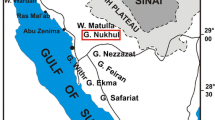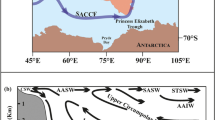Abstract
The article analyzes the author’s own data on the species composition of planktonic foraminifera tests from Upper Cretaceous sediments in the Indian Ocean, as well as from sections of the marginal shelf seas of Australia. Planktonic foraminifera species are grouped and arranged into a climate series. Analysis of the change in the systematic composition of foraminifera made it possible to identify periods of extreme and intermediate climatic conditions in the Late Cretaceous.






Similar content being viewed by others
REFERENCES
M. S. Barash, Planktonic Foraminifers in Sediments of Northern Atlantic (Nauka, Moscow, 1970) [in Russian].
M. S. Barash, Quaternary Paleoceanology of the Atlantic Ocean (Nauka, Moscow, 1988) [in Russian].
V. N. Beniamovskii, A. S. Alekseev, A. V. Podgaetskii, et al., “Upper Campanian-lower Maastrichtian sections of northern Rostov oblast. Article 2. Depositional environments and paleogeography,” Stratigr. Geol. Korrel. 22, 518–537 (2014).
N. S. Blyum and E. A. Sokolova, “Climatic zonation of the Pacific Ocean in Miocene as inferred from the results of analysis of planktonic foraminifer complexes,” Byull. Mosk. Obshch. Ispyt. Prir., Otd. Geol. 62 (6), 116–130 (1987).
L. P. Zonenshain, L. A. Savostin, A. P. Sedov, et al., “Global paleogeodynamic reconstructions for last 160 years,” Geotektonika, No. 3, 3–16 (1984).
L. F. Kopaevich and E. A. Sokolova, “Comparison of oryctocenoses of Maastrichtian planktonic foraminifers from some Atlantic Ocean wells and epicontinental circum-Caspian basins,” Okeanologiya (Moscow) 32, 316–325 (1992).
L. F. Kopaevich and E. A. Sokolova, “Comparison of complexes of Santonian planktonic foraminifers from Pacific Ocean wells and some epicontinental basins of the Northern Hemisphere,” Byull. Mosk. Obshch. Ispyt. Prir., Otd. Geol. 78 (5), 60–70 (2003).
L. F. Kopaevich and T. N. Gorbachik, “Shell morphology of cretaceous planktonic foraminifers as a means for paleoenvironment reconstructions,” Paleontol. J. 51, 1–12 (2017).
N. S. Os’kina, E. V. Ivanova, and N. S. Blyum, “Climatic zonation of Atlantic, Indian, and Pacific oceans in Pliocene,” Dokl. Akad. Nauk SSSR 264, 400–407 (1982).
E. A. Sokolova, Paleoceanological Reconstructions of the Pacific Ocean for the End of Late Cretaceous (Maastrichtian) Period as Inferred from Planktonic Foraminifers, Available from VINITI, No. 1351-98 (Moscow, 1998).
E. A. Sokolova, “Reflection of climatic zonality of Late Cretaceous in the World Ocean according to planktonic foraminifers,” Byull. Mosk. Obshch. Ispyt. Prir., Otd. Geol. 76 (4), 57–61 (2001.
E. A. Sokolova, “Climatic zonation of Atlantic and Indian oceans in Late Turonian, Coniacian, and Santonian as evidenced from planktonic foraminifers,” in Proceedings of the Second All-Russian Conference “The Cretaceous System of Russia: Stratigraphy and Paleogeography,” Ed. by V. V. Arkad’ev and V. A. Prozorovskii (Institute of Earth Crust, St. Petersburg State University, St. Petersburg, 2005), pp. 102–110.
E. A. Sokolova, “Reflection of climatic zonality of Turonian in the World Ocean according to planktonic foraminifers,” Vestn. Dnepropetrovsk. Univ., Ser. Geol. Geogr. 8 (7), 3–9 (2005).
E. A. Sokolova, “Comparison of Cenomanian-Turonian thanatocenoses planktonic foraminifers from the ocean wells, Carpatian sections, and other epicontinental basins,” in Paleontology and Biostratigraphy of Proterozoic and Phanerozoic of Ukraine (Institute of Geographical Sciences, National Academy of Sciences of Ukraine, Kyiv, 2006), pp. 138–144.
E. A. Sokolova, “Reflection of climatic zonality of Cenomanian in high altitudes of the Southern Hemisphere,” Vestn. Dnepropetrovsk. Univ., Ser. Geol. Geogr. 11 (9), 54–59 (2007).
E. A. Sokolova and O. Yu. Kochetov, “Climatic zonality of the Atlantic and Pacific oceans in Cenomanian according to planktonic foraminifers,” in Proceedings of the Seventh All-Russian Conference “The Cretaceous System of Russia: Stratigraphy and Paleogeography,” (Dal’nauka, Vladivostok, 2014), pp. 295–299.
E. A. Sokolova, “Migration of climatic zones in the World Ocean during Cenomanian according to foraminiferal analysis,” in Proceedings of the III All-Russian Scientific-Practical Conference “Life Development during Abiotic Changes on the Earth” (Institute of Geography, Siberian Branch, Russian Academy of Sciences, Irk-utsk, 2014), pp. 214–219.
E. A. Sokolova, “Climatic zonality and biological diversity of planktonic foraminifers in Cenomanian-Turonian time interval,” in Proceedings of the All-Russian Scientific-Practical Conference “Geology and Biological Diversity of Mesozoic-Cenozoic Deposits in the South of Russia” (Goryachii Klyuch, 2015), pp. 151–157.
E. A. Sokolova, “Evolution of climatic zones in the World Ocean on the border of Early and Middle Turonian according to planktonic foraminifers,” in Proceedings of the Eighth All-Russian Conference “The Cretaceous System of Russia: Stratigraphy and Paleogeography,” (Chernomorpress, Simferopol, 2016), pp. 260–263.
E. A. Sokolova, “Climatic zonality Middle and Late Turonian in the World Ocean according to planktonic foraminifers,” in Proceedings of the All-Russian Scientific-Practical Conference “Geology and Biological Diversity of Tethys and East Paratethys” (Goryachii Klyuch, 2017), pp. 84–90.
A. W. H. Bé, “Ecological, zoogeographic and taxonomic review of recent planktonic foraminifera,” in Oceanic Micropaleontology (Academic, London, 1977), Vol. 1, pp. 76–88.
D. J. Belford, “Stratigraphic and micropaleontology of the Upper Cretaceous of Western Australia,” Geol. Rundsch. 74, 629–647 (1958).
D. J. Belford, “Upper Cretaceous foraminifers from the Toolonga Calcilulite and Gingin chalk, Western Australia,” Bull. Austral. Bur. Miner. Resour. Geol. Geophys. 57, 1–198 (1960).
D. J. Belford, “A probably Coniacian (Late Cretaceous) foraminiferal fauna, Carnarvon Basin, Western Australia,” Bur. Miner. Resour. Aust. Bull. 217, 11–27 (1983).
K. L. Bice, B. T. Huber, and R. D. Norris, “Extreme polar warmth during the Cretaceous greenhouse,” Paleoceanography 18 (2), 1–11 (2003).
C. L. Briena, S. A. Robinsona, R. D. Pancostbc, et al., “Cretaceous sea-surface temperature evolution: Constraints from TEX86 and planktonic foraminiferal oxygen isotopes,” Earth-Sci. Rev. 172, 224–247 (2017).
L. J. Clarke and H. C. Jenkyns, “New oxygen isotope evidence for long-term Cretaceous climatic change in the Southern Hemisphere,” Geology 27, 699–702 (1999).
R. Coccioni and I. Premoli Silva, “Revised Upper Albian–Maastrichtian planktonic foraminiferal biostratigraphy and magnetostratigraphy of the classical Tethyan Gubbio section (Italy),” Newslett. Stratigr. 48, 47–90 (2015).
F. Falzoni, M. R. Petrizzo, K. G. MacLeod, and B. T. Huber, “Santonian-Campanian planktonic foraminifera from Tanzania, Shatsky Rise and Exmouth Plateau: Species depth ecology and paleoceanographic inferences,” Mar. Micropaleontol. 103, 15–29 (2013).
F. Falzoni, M. R. Petrizzo, L. J. Clarke, et al., “Late Cretaceous oxygen- and carbon-isotope trends and planktonic foraminiferal turnover: A new record from the southern midlatitudes,” Geol. Soc. Am. Bull. 128, 1725–1735 (2016).
M. B. Hart, “Climatic modeling in the Cretaceous using the distribution of planktonic Foraminiferida,” in Climates: Past and Present, Geological Society Special Publications (Geological Society, London, 2000), Vol. 181, pp. 33–41.
R. Herb, “Cretaceous planktonic foraminifera from the Eastern Indian Ocean,” Initial Rep. Deep Sea Drill. Proj. 26, 745–796 (1974).
S. D. Hondt and M. A. Arthur, “Deep water in the late Maastrichtian ocean,” Paleoceanography 17 (1), 8-1–8-11 (2002).https://doi.org/10.1029/1999PA000486
B. T. Huber, “Maastrichtian planktonic foraminifer biostratigraphy and the Cretaceous/Tertiary boundary at ODP Hole 738C (Kerguelen Plateau, southern Indian Ocean),” Proc. Ocean Drill. Program: Sci. Results 119, 451–465 (1991).
B. T. Huber, R. D. Norris, and K. G. MacLeod, “Deep-sea paleotemperature record of extreme warmth during the Cretaceous,” Geology 30, 123–126 (2002).
B. T. Huber, M. R. Petrizzo, D. K. Watkins, et al., “Correlation of Turonian continental margin and deep-sea sequences in the subtropical Indian Ocean sediments by integrated planktonic foraminiferal and calcareous nannofossil biostratigraphy,” Newslett. Stratigr. 50, 141–185 (2017).
Initial Reports of the Deep-Sea Drilling Project Hole 264 (Scripps Institution of Oceanography, University of California, San Diego, 1975), Vol. 28, pp. 19–48.
Initial Reports of the Deep-Sea Drilling Project Hole 764A (Scripps Institution of Oceanography, University of California, San Diego, 1990), Vol. 122, pp. 353–384.
L. Kopaevich and V. Vishnevskaya, “Cenomanian–Campanian (Late Cretaceous) planktonic assemblages of the Crimea–Caucasus area: Palaeoceanography, palaeoclimate and sea level changes,” Palaeogeogr., Palaeoclimatol., Palaeoecol. 441, 493–515 (2016).
V. A. Krasheninnikov, “Cretaceous and Paleogene planktonic foraminifera,” Initial Rep. Deep Sea Drill. Proj. 27, 663–671 (1974).
B. Mc Gowran, “Late Cretaceous and Early Tertiary correlations in the Indo-Pacific region,” Geol. Soc. India Mem., No. 2, 335–360 (1968).
B. Mc Gowran, “Maastrichtian to Eocene foraminiferal assemblages in the Northern and Eastern Indian Ocean region,” in Indian Ocean Geology and Biostratigraphy (Washington, 1977), pp. 417–458.
M. R. Petrizzo, “Palaeoceanographic and palaeoclimatic inferences from Late Cretaceous planktonic foraminiferal assemblages from the Exmouuth Plateau (ODP Sites 762 and 763, eastern Indian Ocean),” Mar. Micropaleontol. 45, 117–150 (2002).
P. G. Quilty, “Upper Cretaceous planktonic foraminifers and biostratigraphy,” Proc. Ocean Drill. Program: Sci. Results 120, 371–392 (1992).
P. G. Quilty, “Data report: Studies into the paleontology of the Cretaceous of the Indian Ocean basin,” Proc. Ocean Drill. Program: Sci. Results 120, 1079–1090 (1992).
F. Robaszynski, “Planktonic foraminifera: Upper Cretaceous,” in Mesozoic and Cenozoic Sequence Stratigraphy of European Basins, SEPM Society for Sedimentary Geology vol. 60 (Society for Sedimentary Geology, Tulsa, OK, 1998).
F. Robaszynski and M. Caron, “Foraminifères planktoniques du Crètacè; commentaire de la zonation Europe-Mediterraneè,” Bull. Soc. Geol. France. 166, 681–692 (1995).
F. Robaszynski, J. Gonzalez, D. Linares, et al., “Le Cretace superieur de la region de Kalaatsenan, Tunisie Centrale. Litho-Biostratigraphieintegree,” Bull. Cent. Rech. Explor. Prod. 22, 359–490 (2000).
C. R. Scotese, L. M. Gahagan, and R. L. Larson, “Plate tectonic reconstructions of the Cretaceous and Cenozoic ocean basins,” Tectonophysics 155, 27–48 (1988).
C. R. Scotese, “Jurassic and Cretaceous plate tectonic reconstructions,” Palaeogeogr., Palaeoclimatol., Palaeoecol. 87, 493–501 (1991).
D. K. Watkins, G. Q. Patrick, B. A. Mohr, et al., “Paleontology of the Cretaceous of the Kerguelen Plateau,” Proc. Ocean Drill. Program: Sci. Results 120, 951–960 (1992).
A. A. H. Wonders, “Cretaceous planktonic foraminiferal biostratigraphy, Leg 122, Exmouth Plateau, Australia,” Proc. Ocean Drill. Program: Sci. Results 122, 587–599 (1992).
Y. D. Zakharov, O. P. Smyshlyaeva, Y. Shigeta, et al., “Reconstruction of Campanian Sea surface temperatures: Evidence from new isotopic data,” in Proceedings of the Sixth International Symposium of IGCP 434 “Cretaceous Geology and Resources in South and East Asia and Adjacent Areas” (Hanoi, 2004), pp. 114–122.
Y. D. Zakharov A. M., Popov, Y. Shigeta, et al., “New Maastrichtian oxygen and carbon isotope record: Additional evidence for warm low latitudes,” Geosci. J. 10, 339–359 (2006).
ACKNOWLEDGMENTS
The author considers it her duty to express gratitude to the leadership of the Ocean Deep-Water Drilling Project for the core samples, as well as to V.N. Benyamovsky and Dr. F. Playtord for samples from sections of Australia’s marginal shelf seas.
Funding
The work was performed as part of a state assignment (topic no. 0149-2018-0005).
Author information
Authors and Affiliations
Corresponding author
Rights and permissions
About this article
Cite this article
Sokolova, E.A. Crucial Boundaries in the Development of the Late Cretaceous Biota of Planktonic Foraminifera in the Southern Indian Ocean. Oceanology 59, 975–988 (2019). https://doi.org/10.1134/S0001437019060201
Received:
Revised:
Accepted:
Published:
Issue Date:
DOI: https://doi.org/10.1134/S0001437019060201




